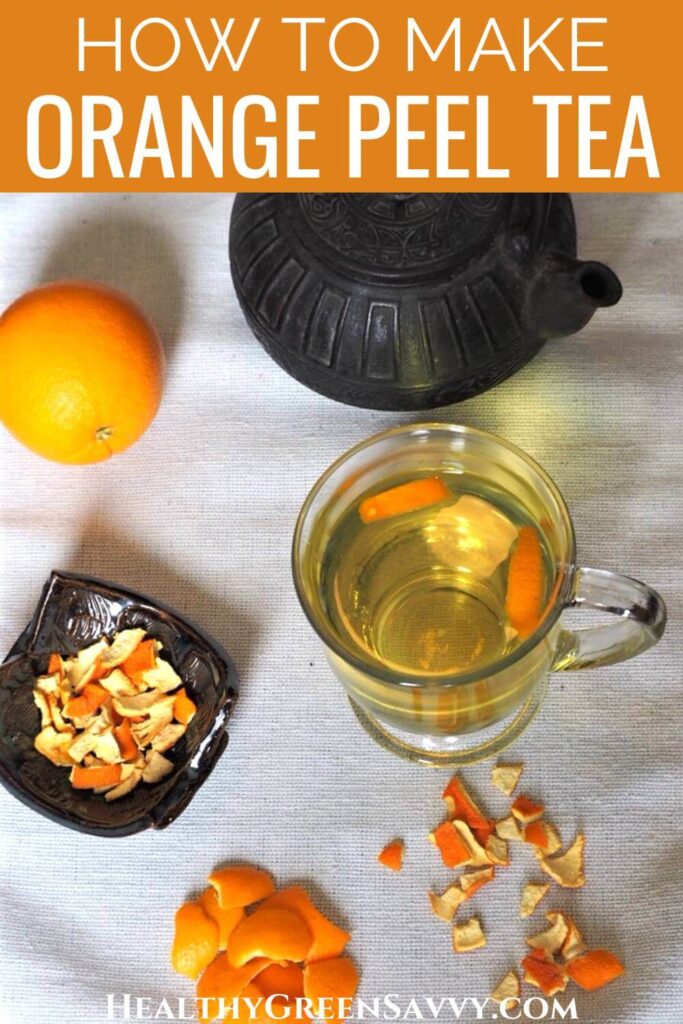Last Updated on August 1, 2024
Did you know you can make tea from orange peels? This easy orange peel tea is a flavorful and healthy way to make the most of your produce purchases. Orange peels are not only edible, they’re tasty and medicinally useful as well. Though there are dozens of uses for orange peels, today we’ll focus on making a simple and delicious tea. Read on to find out how to make tea from orange peels.

WHY MAKE ORANGE PEEL TEA?
Like banana peel tea, orange peel tea is one of those brilliant uses for things people throw away without realizing that they’re not only edible but nutritious as well. In the case of orange peels, the tea you make with them also has medicinal value.
How cool is it to make something yummy and good for you with something most folks put in the trash? Adding orange peel tea to your tea rotation and home remedy toolkit is one easy way to get more out of the produce you buy.
There are so many other ways you can use parts of food you buy that typically get chucked. Check out this collection of root to stem recipes for numerous more ways to waste less food.
WHAT DOES ORANGE PEEL TEA TASTE LIKE?
Orange peel tea has a pleasant citrusy flavor. It’s not as sweet as oranges, but it’s also not as bitter as the peel if you nibble it plain.
Tea made with fresh peels has a brighter flavor, while dried orange peels make a mellower tea.
Orange peel tea can be enjoyed on its own, or you can combine it with other beneficial and tasty herbs. Ginger tea with orange peel is a winning combination for dealing with a cold with a wet cough. Thyme tea is another soothing drink when you have a cold or cough, and you can add orange peels to that for extra flavor and medicinal benefits.
Cinnamon and honey are other tasty flavors that pair well with orange peels, or you can add your favorite black or green tea.
Small amounts of dried orange peel also make a nice addition to herbal sleep blends, adding flavor, nutrients, and medicinal compounds.
ORANGE PEEL TEA BENEFITS
Besides making a tasty tea with something that would otherwise go to waste, orange peel tea has other benefits worth knowing about.
Contains vitamin C and other nutrients
Orange peels contain nearly twice the vitamin C of oranges, though most of us are far more likely to eat a whole orange than a whole orange peel. Orange peels also contain potassium, vitamin A, and small amounts of other vitamins and minerals as well as fiber according to the FDA. Though you would have to eat the peel left in the teapot to get all these nutrients. You definitely can; it’s just not the yummiest snack I can think of 😉
Source of polyphenols and medicinal uses
Orange peels are a rich source of polyphenols, plant compounds with beneficial effects on health. Research has explored polyphenols in citrus peels for a number of possible therapeutic uses, such as antioxidant and anti-inflammatory activity, as a diabetes treatment, and for preventing and treating cancer. Orange peels also have antimicrobial properties, and the scent of their oils may also promote relaxation and soothe anxiety.
If you want to know more about orange peel benefits, you’ll find more than 4000 studies on orange peels in the PubMed database.
Orange peels are one of many herbs for cough to try the next time you come down with a cold. Here are a bunch more herbs for colds to explore.
FRESH VS DRIED ORANGE PEELS FOR MAKING TEA

You can use either fresh or dried orange peels for tea. You’ll need more peel per cup of water if you use fresh, and as with other herbal teas, the flavor will be somewhat different.
I prefer the flavor of dried orange peel. I’d describe fresh peel’s flavor as brighter and more assertive, while dried is more mellow and smooth.
We tend to eat more oranges in winter, when all the summer fruits are a distant memory. It’s unlikely you’ll be able to use all those peels fresh, so drying some for after orange season makes sense. With all the other fruits available in summer, not many people bother with oranges, but the dried peels are still nice for herbal tea blends or for making iced orange peel tea on a hot day. It’s very refreshing!
It’s especially helpful to have those dried peels on hand to use when someone has a cough. I tend to dry any peels I have after eating an orange in winter and put them in a jar to have ready when they’re needed. Dried orange peels can be used in tea on their own or with other herbs to soothe respiratory illnesses.
The low-humidity air of our heated houses in winter works perfectly for air-drying orange peels, no dehydrator or oven-drying necessary. Drying without added heat also helps preserve their heat-sensitive vitamin C.
If you’d rather use a dehydrator, dry your orange peels at a low temperature (around 100 degrees F). You could also use your oven on the lowest setting, but you’ll get higher temperatures than ideal for preserving the vitamin C in the peels, plus you’ll need to watch carefully to keep them from burning.
How to air-dry orange peels:
Rinse and peel oranges. Tear or cut the peel into small pieces or strips, about 1/4 inch squares. It’s fine if you don’t want to bother making them small, though smaller pieces will release their compounds more readily and make it easier to measure for tea.
Arrange peels on a plate, screen, or clean towel and allow them to sit for 3 to 4 days, until they’re no longer pliable.
Once fully dried, you can store orange peels in an airtight container for up to a year.
If you have surplus oranges, you can also make dried orange slices, which can be used as a pretty addition to your orange peel tea, or for decorations or crafts.
RECOMMENDED SUPPLIES FOR MAKING ORANGE PEEL TEA
I highly recommend choosing organic oranges for orange peel tea so you don’t wind up with pesticide residues in what’s supposed to be a healthy drink.
All you need to make orange peel tea is some orange peels and hot water, but a couple of additional tools can help you make the healthiest, best-tasting tea possible.
–> Always use a quality water filter. Most municipal water contains hundreds of unregulated chemicals you don’t want in your tea! Here’s what to know about choosing an effective water filter to remove them. Worth noting: Most popular filters only remove a fraction of the chemical contaminants common in municipal water supplies.
I like to boil water in an electric kettle to save energy, even if I’ll be simmering things on the stove. Choose a metal or glass kettle rather than plastic, as heating water in plastic leaches plastic chemicals you’re better off avoiding.
I just got a variable temperature kettle for Christmas, and I love being able to set just the right temperature for my favorite white and green teas as well as my go-to herbal teas and black tea. Some models don’t cost much more than a standard kettle, but if you’d rather go with a simpler version, you’ll be just fine.
HOW TO MAKE TEA FROM ORANGE PEELS
You can make orange peel tea in several ways, with dried or fresh or orange peels, by simmering or steeping, with or without additional flavors. Try several ways to make orange peel tea and find the one that suits your tastes best.
My favorite way to make orange peel tea is using dried peels simmered in a pot for 10-15 minutes. I like it unsweetened, but you can add sweetener to taste if you prefer.
Some people prefer to use a peeler to remove only the outer orange layer of the peel, leaving the white pith on the orange. The pith can add a bitter flavor, though it tends to be less noticeable with dried orange peels.
A medium orange has roughly 1/4 cup fresh chopped peel), enough peel for about 2 cups of water. It helps to press orange peels into a measuring spoon to ensure you’re getting enough peel to flavor your tea.
While you can steep rather than simmer fresh orange peels, the flavor is so subtle, it’s hard to call it tea. It’s very subtly infused water.
ORANGE PEEL TEA RECIPE

Easy Orange Peel Tea Recipe
This easy orange peel tea makes a tasty drink out of something you'd usually throw away. Orange peel tea contains compounds beneficial for health and helpful for soothing coughs.
Ingredients
- 1/4 cup fresh orange peel (or 1/8 cup dried), chopped into small pieces)
- 2 cups filtered water
Instructions
- Place orange peels and water in a pot and bring to a boil.
- Turn off the heat and allow to steep for at least 10 minutes. Don't leave it too long or it may become bitter.
- Strain and enjoy.
- Alternate method:
- If you really don't want to dirty a pot or use the stove, you can steep dried orange peel, using more generous amounts of peel per cup of water. Taste it after 10 minutes and let it steep longer if you want more flavor. Don't let it go too long, or it will become bitter.
Notes
Because orange peels can vary so much in size or shape, the measurements above should be considered a guideline. Since you can always dilute too-strong tea but can't make weak tea stronger, I always think it's best to err on the side of using more herb and then adding more water if it comes out too strong.
VARIATIONS TO TRY
You can definitely drink tea made with nothing but orange peels, but it’s nice to mix things up from time to time. Other options to consider:
- Orange peel and ginger tea (an excellent cold and cough remedy)
- Orange peel + cinnamon chips or cinnamon stick
- Orange peel + chai spices
- Orange peel + your favorite black tea
Have you tried orange peels in tea? What did you think?
Save this orange peel tea recipe for later!


Susannah is a proud garden geek and energy nerd who loves healthy food and natural remedies. Her work has appeared in Mother Earth Living, Ensia, Northern Gardener, Sierra, and on numerous websites. Her first book, Everything Elderberry, released in September 2020 and has been a #1 new release in holistic medicine, naturopathy, herb gardening, and other categories. Find out more and grab your copy here.

 Hi, I'm Susannah, a garden geek, energy nerd, and fan of healthy food and natural remedies. Need some simple, practical solutions for living healthier and greener? You've come to the right place! More about me and my green projects
Hi, I'm Susannah, a garden geek, energy nerd, and fan of healthy food and natural remedies. Need some simple, practical solutions for living healthier and greener? You've come to the right place! More about me and my green projects